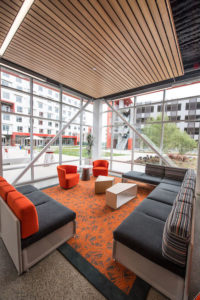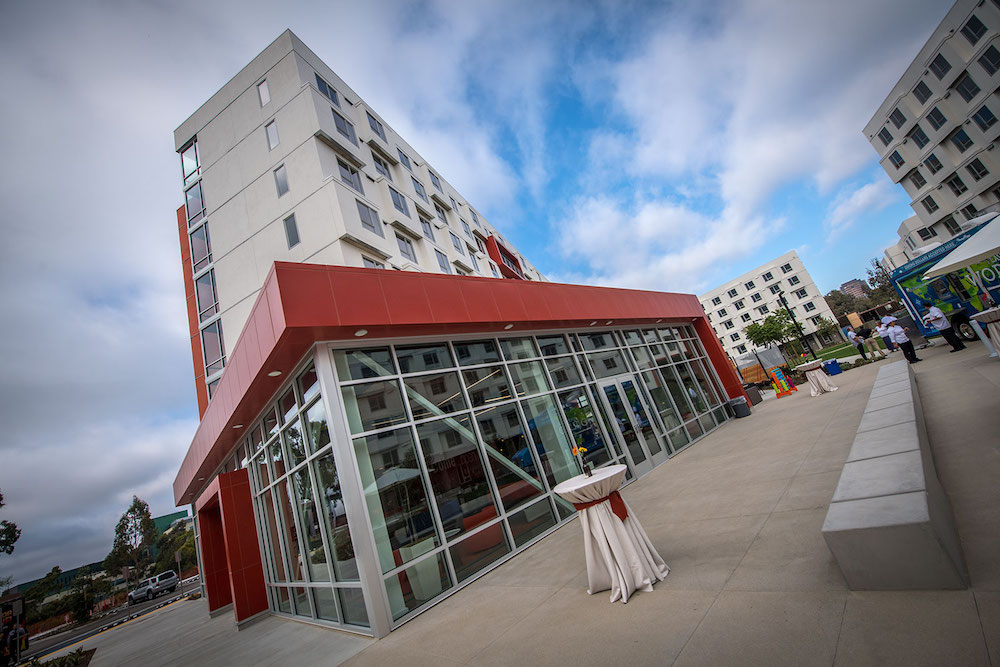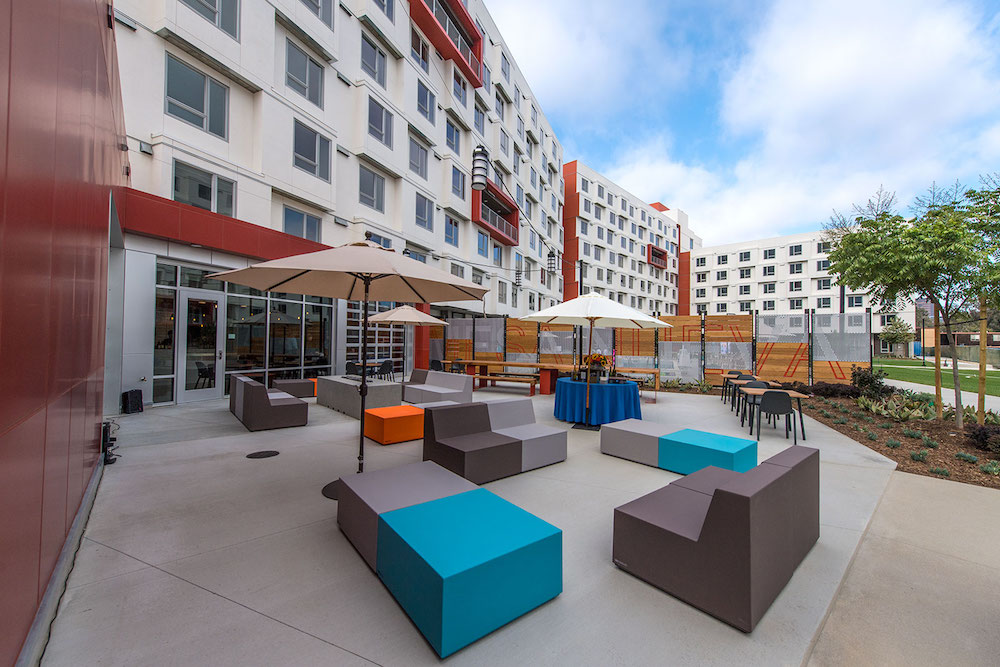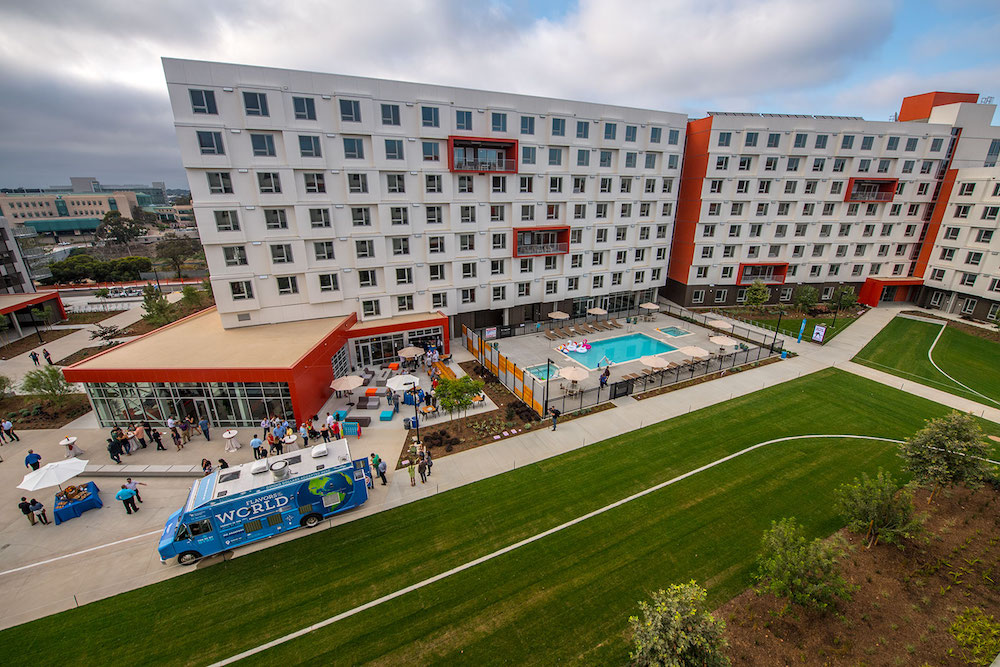Daily Business Report-Sept. 22, 2017
Mesa Nueva was completed in time for the start of the fall quarter on Sept. 28. (Photo courtesy of UC San Diego)
UC San Diego Unveils One of Nation’s
Largest Graduate Housing Projects
By Christine Clark | UC San Diego News Center
Graduate and professional students have begun moving into UC San Diego’s Mesa Nueva, one of the largest graduate and professional student housing programs in the UC system and one of the biggest in the country.

The project was completed in time for the start of the fall quarter on Sept. 28.
In addition to being on track for LEED (Leadership in Energy and Efficient Design) Gold Certification, the new units answer a demand for both housing space and a greater sense of community for students. The new developments north of La Jolla Village Drive and west of Regents Road replaced 86 older units, built nearly 50 years ago, with new layouts and a number of new amenities, such as a small grocery store, coffee shop and other elements.
The five side-by-side buildings were constructed on 10 acres that are part of UC San Diego’s existing Mesa Residential Apartments. The apartments are along Miramar Street, on a loop that connects to Regents Road. The new units surround an open space where students can gather to play volleyball, bocce ball or relax on the grass.

“With more students living on campus, this will help lessen the impact on the surrounding community with regards to issues such as housing, traffic and parking. We will continue to engage the public as we move through this process,” said Mark Cunningham, assistant vice chancellor of housing, dining hospitality.
Caltrans is in the process of building a new Gilman Bridge adjacent to Mesa Nueva over Interstate 5 that links the east and west parts of the campus together via Gilman Drive and Medical Center Drive. To enhance this new east/west campus connectivity, UC San Diego will construct a pedestrian/bike bridge that will provide a direct connection for the students in the Mesa Residential Apartments neighborhood to the new bridge, which will allow them easy access to campus without needing to use a personal vehicle.

With the addition of the bridge, and the new layout of the residences, Mesa Nueva is designed to create a greater sense of community between the campus and the graduate and professional students.
The average age of UC San Diego’s graduate students is 25, and the residents live on an average stipend of $19,000 a year and work on campus. This makes it important for them to live nearby at an affordable price. The university strives to keep rental rates at least 20 percent below the adjacent private sector market, charging on average about $750 a month per person with all costs included.
UC San Diego’s Long Range Development Plan goal is to house at least 50 percent of eligible students on campus. As of fall 2017, that number will be approximately 40 percent; with the additional housing projects underway, the campus expects to be at approximately 49 percent in fall 2020 with more anticipated student growth on the way.
__________________
Report: City Needs 150,000 to 220,000
Housing Units Over Next 10 Years
The city of San Diego can create enough additional housing to meet its need for 150,000 – 220,000 housing units over the next 10 years if the majority of the proposals in a new San Diego Housing Commission report are implemented, the commission reported.
SDHC developed the report, “Addressing the Housing Affordability Crisis: San Diego Housing Production Objectives 2018-2028.” in collaboration with City Council members Scott Sherman and David Alvarez, chair and vice chair, respectively, of the City Council’s Smart Growth & Land Use Committee. The report has been presented to the committee.
“This report, for the first time reveals researched housing goals by community that must be reached in order to solve our region’s housing crisis. Talk is cheap; we can now measure our success and hold ourselves accountable in achieving housing affordability in our region,” Sherman said.
“The findings of this report send a clear message: We should care more about building homes for regular San Diegans than building luxury mansions for the wealthy,” said Alvarez said.
SDHC engaged a global policy and research consultant to conduct the study of the city’s overall housing production needs, its current supply, and its available space to build additional homes.
“The good news is that the study found that the City has the ability to meet its housing needs over the next 10 years. Our new report identifies the five main sources of these potential new housing units — as well as actions that can be taken to expedite housing production,” said SDHC President & CEO Richard C. Gentry.
The new report is the next step in a process that SDHC started nearly two years ago when it published its report, “Addressing the Housing Affordability Crisis: An Action Plan for San Diego,” which included 11 recommended actions at the local, state and federal level to reduce costs and increase housing production. To date, action has been taken on nine of those 11 recommendations. Setting annual housing production goals was the first of the 11 recommendations in that report.
__________________
Exosomes are the Missing Link
to Insulin Resistance in Diabetes
Chronic tissue inflammation resulting from obesity is an underlying cause of insulin resistance and type 2 diabetes. But the mechanism by which this occurs has remained cloaked, until now.
In a paper, published in the journal Cell on Sept. 21, University of California San Diego School of Medicine researchers identified exosomes — extremely small vesicles or sacs secreted from most cell types — as the missing link.
“The actions induced by exosomes as they move between tissues are likely to be an underlying cause of intercellular communication causing metabolic derangements of diabetes,” said Jerrold Olefsky, professor of medicine in the Division of Endocrinology and Metabolism at UC San Diego School of Medicine and senior author of the paper. “By fluorescently labeling cells, we could see exosomes and the microRNA they carry moving from adipose (fat) tissue through the blood and infiltrating muscle and liver tissues.”
__________________

Mingei International Museum Promotes
Director Rob Sidner and 2 Senior Managers
After 12 years as director of Mingei International Museum, the organization’s trustees unanimously agreed to name Rob Sidner the executive director and CEO. Th new title is a reflection not only of Sidner’s growth as a leader of the museum, but the growth and maturity of the organization as a whole, the board said in a statement.
“The museum has advanced considerably as a more professional institution — respected and supported by a broad community — under Sidner’s capable leadership,” according to the board. “The size of the staff and the annual operating budget of the Museum have more than doubled during his tenure. The permanent collection has been augmented and refined, the exhibition program has gained critical acclaim and driven audience growth, and the museum now has a robust education program serving students and educators throughout the region.”
At Sidner’s recommendation, two senior managers were also promoted:
Christine Knoke Hietbrink, serving as chief curator and director of exhibitions, becomes deputy director, chief curator and director of exhibitions. She came to Mingei seven yeasrs ago from the Norton Simon Museum in Pasadena.
Jessica Hanson York, serving as director of external relations, becomes deputy director and chief advancement officer. She comes from a career in public broadcasting and the arts and has been with the museum for over six years.
The museum is currently seeking a new deputy director and chief financial officer.
The museum’s current board officers, chaired by Courtenay McGowen, have agreed to continue in their roles for another two years, seeing the organization through its capital campaign and physical transformation.
The board officers are: Courtenay McGowen (chair), Carol Hinrichs (vice chair), Terri Peterson Zimdars (secretary), Howard Weiner (treasurer) and Carolyn Sheets Owen-Towle (immediate past chair). Other trustees are: Rhonda Brown, Patricia Cué, Roger Cornell, Carlos Cristiani, James Dawe, Katy Dessent, Carol Dickinson, Bob Kelly, Maureen Pecht King, Theresa F. Lai, Bosco Luján Valladolid, Greg Malone, Audrey Ratner, Gail Schneider, John Seiber, Kimberly Shores, Abby Weiss and Richard Woltman.
__________________
Rady School of Management
Hits 150 Startup Company Milestone
With a thriving innovation ecosystem, San Diego is one of the top startup cities in the U.S. and the Rady School of Management has played a vital role in stoking the region’s economic engine. The school’s students and alumni have founded 150 operational startup companies since the school’s first MBA class graduated in 2006.
Over 70 percent of those companies remain in San Diego, contributing over $2 billion to the local and national economy.
“The Rady School’s approach is to support startups from ideation and development to the successful launch and growth of a company,” said Rady School Dean Robert S. Sullivan. “In the past decade, 150 startups have been founded and 15 percent of Rady MBA graduates are operating a successful startup company. That is a strong testament to the effectiveness of our MBA program and accelerators.”
The startup companies span industries including biotech, technology, consumer products, medical devices, healthcare and consulting. Many of these companies have received industry awards, secured funding and commercialized. In fact, in the first half of 2017, Rady MBA startups raised over $75 million in financing.
__________________
Contract Awarded for Runway Work
at San Diego International Airport
Granite Construction Inc. has been awarded a $23 million runway rehabilitation contract by the San Diego County Regional Airport Authority for work on the San Diego International Airport.
The work includes milling and replacing approximately 2.5 million square feet of asphalt concrete pavement, reconstruction of a new taxiway, upgrading of lighting and signage, and new striping and marking.
Construction is scheduled to begin in October 2017 and conclude in September 2018.
__________________
Sempra Energy CEO Again Named
Among ‘Most Powerful Women in Business’

For the seventh consecutive year, Fortune magazine has named Debra L. Reed, chairman, president and CEO of Sempra Energy, to the magazine’s “Most Powerful Women in Business” list. Reed is ranked No. 20 in 2017, up from No. 22 in 2016.
In compiling the list, Fortune editors consider four criteria: the size and importance of the woman’s business in the global economy; the health and direction of the business; the arc of the woman’s career; and social and cultural influence. Reed, 61, has served as Sempra Energy’s CEO since 2011, as the company’s chairman since 2012, and president since March 2017. She has spent her entire 38-year career with the Sempra Energy companies.
__________________
AMN Healthcare Named Largest
Health Care Staffing Company
AMN Healthcare announced that it has again been named the largest health care staffing company in the U.S. by Staffing Industry Analysts (SIA).
The SIA report ranks firms based on company-provided and/or estimated 2016 U.S. temporary health care staffing revenue. The list recognizes overall market share as well as revenue in health care staffing sub-segments.
In addition to taking top honors on the overall ranking, AMN was also named the largest travel nurse staffing firm and the largest allied health care staffing firm in the nation.
__________________
Personnel Announcements
Klinedinst PC Adds 2 Attorneys
Robert M. Shaughnessy and Andrew J. Londerholm have joined the San Diego law office of Klinedinst PC.
Robert M. Shaughnessy joins the firm as senior counsel and brings nearly 20 years of complex law-and-motion and appellate experience to the firm’s Appellate Practice Group, and is knowledgeable in a variety of practice areas. He counsels clients on matters including unfair competition, false advertising, trade secret misappropriation, employment issues, invasion of privacy, director and officer liability, real property law, and trust disputes.
Outside of the legal community, Shaughnessy serves as board member to Improve UC and No Limits Limb Loss Foundation.
Andrew J. Londerholm is an associate attorney and focuses his practice on business-related issues including residential and commercial construction litigation. He represents clients in complex litigation, with significant courtroom and trial experience. He has successfully litigated public and private construction disputes involving sureties, principals, and obligees, as well as matters involving both contract and commercial bonds. Prior to joining Klinedinst, Londerholm’s practice included trust and estate matters, environmental and toxic tort litigation, personal injury, and products liability.



